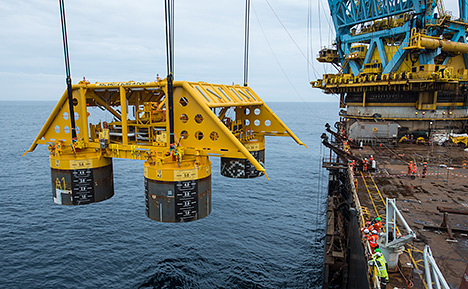Statoil and DNV GL drive subsea factory interface standardisation
Statoil has entered into an agreement with DNV GL to establish an industrial cooperation to introduce an international industry standard for subsea process technology.

Installation of subsea template at the Åsgard field in the Norwegian Sea. (Photo: Øyvind Hagen)
DNV GL will lead a joint industry project (JIP) with important subsea operators to find industrial standards which will make it more profitable to develop larger projects with subsea processing technology.
Subsea developments
Today, subsea developments are characterised by tailor-made solutions. Subsea pumps have been used in many oilfields, and the first subsea compression systems will be installed in 2014 to increase gas production from the Åsgard and Gullfaks fields.
By standardising tie-in technology and module sizes it will be easier to combine different types of technology and modules to adapt developments to project needs.
LEGO bricks
“Think of the modules as LEGO bricks. By having standardised module dimensions, which may be assembled by means of standard tie-ins, we may combine technology from different suppliers, and also cover several needs through subsea solutions. This will reduce costs and increase volume,” explained executive vice president in Technology, Projects & Drilling in Statoil, Margareth Øvrum.
The cooperation project should be established by the end of Q1 2015.
"The industry needs to lower costs to enable more subsea developments and increase the use of subsea processing technology," Øvrum added. During the last 10-12 years, costs related to subsea developments have increased by 250%.
Reduce costs and increase efficiency
Standardisation is one of the improvement measures to reduce costs and increase efficiency in operations which Statoil presented as part of its capital markets day in February this year. Øvrum emphasised that this standardisation will not take place at the cost of new and important technology development.
Øvrum continued: "It is important not only for Statoil, but for the industry in general, that competition is maintained in the development of the process technology itself, and the input which is made to the modules. By standardising the tie-ins and the module sizes, it will be possible to make use of the best technology for each individual function, independent of supplier.
"This will lead to more subsea projects being realised, benefitting both operators and suppliers. We will achieve increased recovery, as more projects will be profitable to develop. Standard solutions will be easier and safer to handle, which will also reduce maintenance costs."
Subsea processing contracts
Earlier in 2014, Statoil awarded contracts for feasibility studies related to the implementation of subsea processing factories. The following three contracts were awarded:
- FMC – Oil boosting case
- Saipem – Åsgard subsea pre-compression case
- Kongsberg – SoW in control systems
Adapted from press release by Katie Woodward
Read the article online at: https://www.oilfieldtechnology.com/exploration/02092014/statoil-and-dnv-gl-in-subsea-standards-alliance-1376/
You might also like
McDermott awarded offshore contract by Brazil's BRAVA Energia
Under the contract scope, McDermott will execute the transportation and installation of flexible pipelines, umbilicals and associated subsea equipment for two new wells at the Papa-Terra field and two new wells for the Atlanta Phase 2 development.


